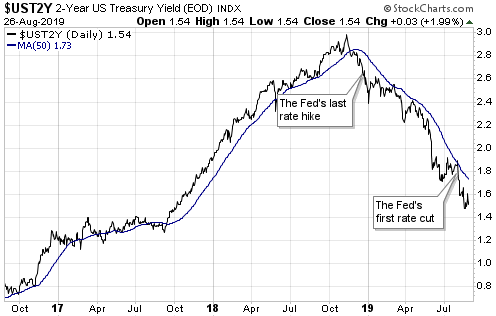The relationship between short-term market interest rates and the interest rates set by the Fed is a complicated one. The market makes predictions about what the Fed is going to do and moves in anticipation, but at the same time the Fed’s interest-rate settings are influenced by what’s happening to market interest rates. Also, market interest rates are determined by factors other than what the Fed is doing or expected to do to its official rate targets, and as a result there are times when the market and the Fed seem to be at odds with each other.
At the moment there is no doubt that the market is leading the Fed. In particular, the Fed has been swayed towards rate cutting partly by the fact that the market has discounted rate cuts. This can be established by comparing recent movements in market interest rates with changes in the Fed’s interest rate targets, which I’ll get to shortly. It can also be established by referring to the Fed’s own statements. For example, the minutes of the July FOMC meeting included the following assessment:
“Participants observed that current financial conditions appeared to be premised importantly on expectations that the Federal Reserve would ease policy to help offset the drag on economic growth stemming from the weaker global outlook and uncertainties associated with international trade as well as to provide some insurance to address various downside risks.”
In essence, the Fed has admitted here to being worried that if it doesn’t cut rates like the market expects then financial conditions could get a lot worse. The implication is that if the market expects the Fed to cut rates, then to avoid disappointing the market (and risking the deterioration of financial conditions) the Fed will cut rates.
I mentioned above that the market’s current leadership can be established by comparing recent movements in market interest rates with changes in the Fed’s interest rate targets. Displayed below is a chart that makes this case. The chart shows the performance of the 2-year Treasury yield and indicates the last two interest-rate changes made by the Fed. Notice that:
1) The 2-year market interest rate began trending downward in early-November of 2018.
2) The Fed made its last rate hike during the second half of December 2018, that is, the Fed was still in rate-hiking mode six weeks after a short-term market interest rate began trending downward.
3) The Fed made its first rate cut at the end of July 2019. By that time, the 2-year market interest rate had been trending downward for almost 9 months.
It’s reasonable to assume that additional Fed rate cuts are on the way. Bear in mind, however, that a few additional rate cuts have already been factored into market prices, so market prices won’t necessarily respond in the obvious way to future Fed rate cuts. Also bear in mind that market interest rates probably will begin trending upward while the Fed and other central banks are still in rate-cutting mode.
 Print This Post
Print This Post

